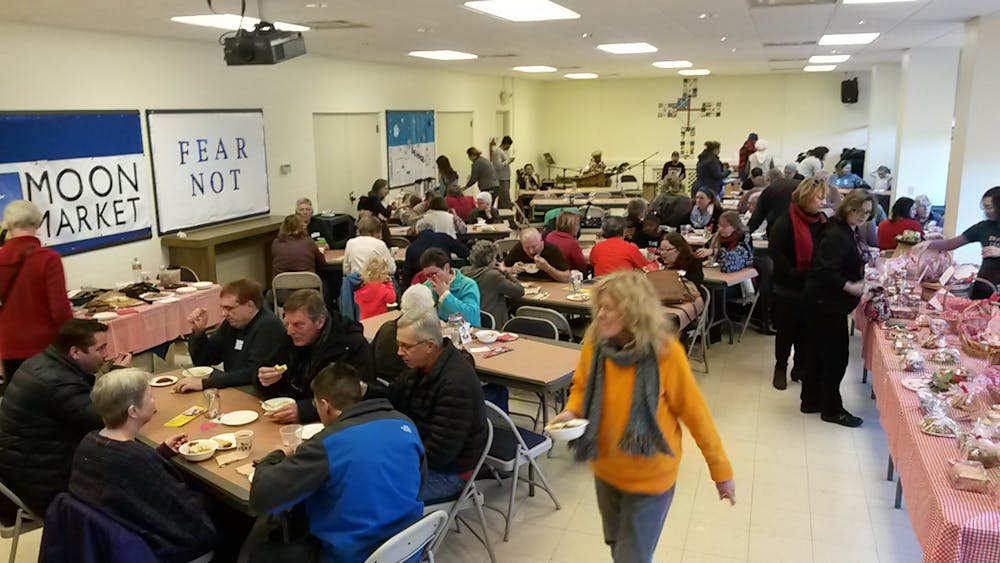February has become “Chili Month” in Oxford. MOON Co-op Market’s annual chili lunch is Saturday, Feb. 17, between 11.30 a.m.-2 p.m. in Oxford’s Holy Trinity Episcopal Church at the corner of Walnut and Poplar Streets. Oxford Kiwanis Club’s chili supper is Thursday, Feb. 29, between 5 - 7 p.m. at Talawanda High School.
For the two events, Oxford residents volunteer to make chili, as well as cornbread and desserts. As the 20 or so donated pots of chili arrive in the kitchen at MOON Co-op Market’s lunch, the three servers this year — my close friend John Hofmann, 13-year-old neighbor Miles Dumyahn, and I — will sort them by meat (beef or poultry) or no meat (vegetarian or vegan), as well as by beans or no beans. The three of us will also taste each one and rank them from mild to spicy.

Pots of chili ready to be taste-tested at the annual competition.
If you are looking to make your own chili, hamburgers or other meat dishes, the two best sources of ground beef in Oxford are Jana and Skyp Harmon’s Caraway Farm (available at Oxford’s Farmers Market) and Daniel and Cindy Kramer’s Brookside Family Farms (available at MOON Co-op Market).
Locally raised beef is more full-flavored, with a “beefier” taste, compared to what is served at fast-food restaurants. The reason for the stronger flavor is that both local farms let their cattle spend much of the day outside where they can feed on grass and corn grown on the farms. In addition, they are not injected with hormones and antibiotics, as is done to cattle raised for large-scale commercial use.
Chili, as we know it, was first sold commercially in the 19th century in San Antonio. So-called Chili Queens prepared at home “bowls o’red,” which they carried to a downtown market until the health department put them out of business in the 1930s.
Chili history prior to the Chili Queens is obscure and disputed. My sentimental vote for the originator of chili is Sister Mary of Agreda (1602-1665), who played an important role in the establishment of missions in New Spain (now Texas).
Sister Mary never left her convent in Spain, but her spirit was thought to be transported frequently by angels to New Spain where she appeared as a mystical apparition preaching Christianity. On one of its return trips back to Spain, Sister Mary’s spirit is believed to have brought along a chili recipe of chili peppers, venison, onions and tomatoes.
In 1977, chili was designated as the Official Texas State Dish. Rather than Sister Mary’s four ingredients, the official Texas chili has just two ingredients: diced or shredded beef and dried chile peppers. President Lyndon Johnson – a True-Texan – once termed any other chili “a weak, apologetic imitation of the real thing.” One wonders what President Johnson would say about our Cincinnati-style chili, which more closely resembles a Mediterranean-style meat sauce than Texas-style chili.

Chili ingredients can include ground beef, diced tomatoes, beans, onion and garlic.
Most chili is made with beans in Ohio, but not in Texas. In 1976, Kent Finlay, owner of Cheatham Street Warehouse, a honky-tonk music venue in San Marcos, Texas, wrote a song called “You Know That Chili Has No Beans.” My nephew Will Hoffman – who now lives in Texas – writes that a well-known expression there is “if you know beans about chili, you know that chili has no beans.”
Nonetheless, some chili at MOON Co-op Market’s chili lunch and Kiwanis chili dinner will contain beans.
Enjoy what you're reading?
Signup for our newsletter
Jim Rubenstein is Professor Emeritus of Geography. At Miami, he was Chair of the Department of Geography and Advisor for the Urban & Regional Planning major. He now writes human geography textbooks and consults on the auto industry at the Federal Reserve Bank of Chicago. In Oxford, he is Treasurer of the Board of Directors of MOON Co-op Market.




